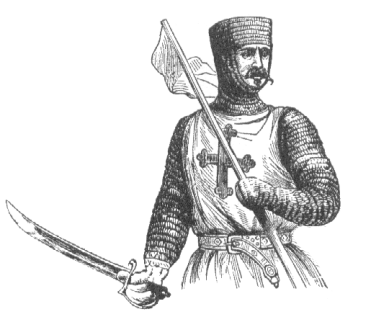
Malcolm Barber and Keith Bate
The Templars
Manchester Medieval Sources (Manchester University Press, 2003) xviii+350pp.
$29.95. ISBN 071905110X.

In the history of the Crusades military orders are certainly one of the
most important creations. Among many of those orders the Templars take up the
first place as the most significant one. Members of that order were often described
as heroes and soldiers of Christ or as villains and sinners.
The order was founded soon after the end of the First crusade in 1119
and it grew to become one of the biggest economical and military powers
of the Medieval Europe.
With the support of the Church and laity the Templars defended the holy
places of the Latin States in Palestine and Syria. Their power grew so
much that they became one of the biggest landowners in the West by the
end of the
thirteenth century. Through their banking services to nobles and king
their power almost exceeded the power of the latter.
In the year 1307 the persecution of the Templars began in France and
it ended with dissolution of the order on the Vienna Council in 1312.
Many historians researched rather short but nonetheless, very interesting
history of the Order. One should say that Malcolm Barber and Keith Bate
deserve a place among the best of those Medievalists. This sourcebook
is a collection
of around 80 sources including Latin and parts of French Rule, Papal
letters and bulls, donations, chronicles of contemporary writers and
eyewitness accounts.
The Sourcebook begins with the Historical introduction from the naissance
of the Order in 1119 to its dissolution in 1312.
Prior to the Historical introduction the authors have presented a short
Chronology of the Order and three maps – The Kingdom of Jerusalem, The
County of Tripoli and the Principality of Antioch and a map of Templar
sites mentioned in this Sourcebook.
In the first chapter, called Foundation and Privileges, Barber and Bate
brought us the most important sources and chronicles that describe the
founding of the Order. Among them one can find accounts of William of
Tyre, Michael
the Syrian, Walter Map and Ernoul. Also included in this chapter is the
Latin Rule of 1129, the Letter of Hugh "Peccator" and Papal bulls
Omne Datum Optimum (1139), Milites Templi (1144) and Militia
Dei (1145).
The second chapter conveys sources that deal with warfare and politics
of the Order. Since the Latin Rule proved to be inadequate for a growing
Order additions were written in French. A section from the French Rule
serves as
an introduction to this chapter and portrays the military conduct of
the Templar knights – making a camp, forming a line of March form Squadrons,
and Charging and is followed by land and fort donations in the Holy Land and
Iberia.
Among other sources in this chapter one should point out the documents
that describe the construction and rebuilding strategic Templar castles of
Athlit
and Safad.
The second chapter ends with a most fascinating document – The report
of James Molay (1306-7), a response of the last Master of the Temple
to the Papal letter about the possibility of a new Crusade in early
14th century. In the following chapter called Religious and charitable functions,
the
authors present translations of the Visions, clauses from the French
rule regulating conventual life and penance for abuse, pilgrimages and
Grants to Churches.
The chapter ends with the Obituary of the Temple at Reims, which records
dates of deaths of those people who donated to the House and for whom
the brothers should pray.
The fourth chapter of this Sourcebook scrutinizes Human and Material
resources of the Templars. Here we can find a series of sources including
wills and grants, donations, acquirement of Irrigation rights (especially
in the
Holy Land), leasing of a tile factory, etc. Through these sources, with
the addition of financial services of the Templars, we can monitor a
gradual economical
growth of the Order. In this chapter captivating sources like colonization
by Moorish settlers, Gathering of the crusading taxes and a list of Templar
inventories in England and Normandy must be brought out.
The fifth chapter comprises of letters and writings of Templar contemporaries.
Among them we can find a well-known work of Bernard from Clairvaux “Liber
ad milites Templi de laude novae militiae” in which the author, through
13 chapters (5 can be found in this Sourcebook), praises the Order and
its function in the Holy Land. What is more, this chapter delivers letters
of Peter
the Venerable, Pope Honorius III and an interesting letter regarding
the proposal of Pope Clement V to unite the Orders of the Temple and Hospital.
The final and most ample chapter, The Trial, attests to Barber’s interest
in the Templar Trials. The sources collected in this chapter follow the historical
outline of the “last days” of the Templars. Beginning with Pope’s
letters to king Phillip IV and followed by the order for arrests and
Episcopal inquiry at Clermont, it ends with Papal Bulls Vox in excelso and
Ad providam.
With the execution of the aforementioned Bulls (Council of Vienna in
1311-12) the Order of the Temple seized to exist and their property was transferred
to the Hospitallers.
The book ends with a bibliography of primary sources and secondary
works for the history of the Templars and a detailed and helpful Index
that
allows the reader to easily find a person, place or a date in
documents scattered throughout the six chapters.
This is a unique collection of translated sources in which, besides
a plethora of documents connected to the naissance, escalation
and demise of the Order, one can find many sources depicting other aspects
of the
Order, including its influence on everyday life in XII
and XIII
century. This book,
a collection of sources, is an indispensable read for
all medievalists, especially
those interested in the history of the Crusades.

Danijel Mondekar
Page Added: February 2004

